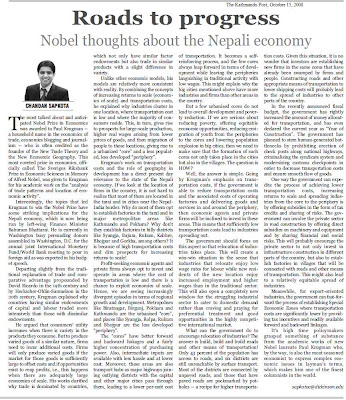New Op-Ed in today’s The Kathmandu Post: Roads to progress: Nobel thoughts about the Nepali economy
I like to apply economics theories I learn in my classroom and from textbooks to the real world. I sometimes struggle to understand some awesome theories if I am not able to relate them with real world issues! O.K. I have been reading Krugman’s work since I first used his Microeconomics book in Econ 101 class during first semester of freshmen year. Since International Economics course has not been offered for some time now, I am following Krugman’s work freely (without order) and whenever I get time (there is always increasing returns while reading his work!). And, since his model on trade theory is relatively realistic than others (I mean the classics), I was wondering the application of his theory on the Nepali economy. I was also interested on policy implication of the theories.
I was thinking about writing an Op-Ed on the application aspect of his theory but kept on postponing the idea! Now, what an appropriate time to write about it. Paul Krugman was awarded the 2008 Nobel Prize in Economics on Monday for his work on the “analysis of trade patterns and location of economic activity.” And, I snatched this occasion (while enjoying no classes/free time during Fall pause!) to write an Op-Ed. Ya, finally! Note that I am just looking at his work that are relevant to the Nepali economy (based on my presumptions about the economy). Other factors like availability of credit, local and regional political situation, raw materials and intermediate inputs availability in a given locality, etc also influence the conclusion/analysis I have outlined in this Op-Ed. Nevertheless, I think the argument derived from the theory does justice to policy interpretation and prescription.
Check out the full piece titled Roads to progress: Nobel thoughts about the Nepali economy
Krugman's work on transportation costs and the role of geography in development has a direct present day relevance to the state of the Nepali economy. If we look at the location of firms in the country, it is not hard to realize that most of them are located in the tarai and in cities near the Nepal-India border. Why do most of them opt to establish factories in the tarai and in major metropolitan areas like Kathmandu and Pokhara? Why don't they establish factories in hilly districts like Syangja, Bajura, Rukum, Kabhre, Bhojpur and Gorkha, among others? It is because of high transportation costs and dim prospects for increasing returns to scale!
Profit-seeking economic agents and private firms always opt to invest and operate in areas where the cost of transportation is low and there is a chance to exploit economies of scale. Hence, we are seeing increasingly divergent episodes in terms of regional growth and development. Metropolises like Biratnagar, Birgunj, Pokhara and Kathmandu are the urbanised “core”, and places like Syangja, Rolpa, Rukum and Bhojpur are the less developed “periphery”.
The “cores” have better forward and backward linkages and a fairly higher concentration of purchasing power. Also, intermediate inputs are available with less hassle and at lower cost. Moreover, these areas are also transport hubs as major highways joining outlying districts with the capital and other major cities pass through them, leading to a lower per-unit cost of transportation. It becomes a self-reinforcing process, and the few cores always leap forward in terms of development while leaving the peripheries languishing in traditional activity with low wages. This might explain why the big cities mentioned above have more industries and firms than other areas in the country.
And some policy stuff:
What can the government do to encourage relocation of industries? The answer is build, build and build roads and other means of transportation! Only 43 percent of the population has access to roads, and six districts are still unreachable by surface transport. Most of the districts are connected by unpaved roads, and those that have paved roads are pockmarked by potholes -- a recipe for higher transportation costs. Given this situation, it is no wonder that investors are establishing new firms in the same cores that have already been swamped by firms and people. Constructing roads and other appropriate means of transportation to lower shipping costs will probably lead to the spread of industries to other parts of the country.
One way the government can expedite the process of achieving lower transportation costs, increasing returns to scale and spreading industries from the core to the periphery is by offering subsidies in the form of tax credits and sharing of risks. The government can involve the private sector in road construction by offering direct subsidies on machinery and equipment and by sharing financial and social risks. This will probably encourage the private sector to not only invest in infrastructure construction in different parts of the country, but also to establish factories in villages that will be connected with roads and other means of transportation. This might also lead to a relatively equitable spread of industries.
Meanwhile, for export-oriented industries, the government can fast-forward the process of establishing Special Economic Zones where transportation costs are significantly lower by providing tax incentives and readily available forward and backward linkages.
A pdf version of the page:
